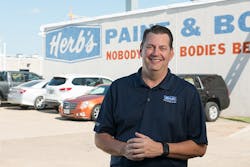Alan Kirkpatrick doesn’t have a background in collision repair. Before coming to work at the Texas-based MSO Herb’s Paint & Body, Kirkpatrick was a senior financial analyst. That didn’t stop his friend from convincing him to come to work at the MSO.
“He kept saying, ‘You’d be great at this,’” Kirkpatrick says. “I joined Herb’s in 1995. I’ve been with the company for 22 years.”
The ‘this’ that his buddy was referring to was the beginning of Herb’s business development initiative. Throughout his time working with the company, Kirkpatrick has been an integral part of growing the company. When Kirkpatrick joined, Herb’s had three locations. Herb’s Paint & Body now has eight locations and generated over $40 million in 2016.
With 22 years at the company and impressive numbers to share, Kirkpatrick is clearly a valued member of the team. So, what exactly does he do?
Kirkpatrick is the executive vice president of business development. And what exactly is a business development employee?
Kirkpatrick laughs and explains that the definition varies from company to company and can assume a variety of different responsibilities. Basically, a business development person is someone who identifies ways that a business can grow and puts his or her efforts behind those initiatives. Based on each shop’s needs, the role may look very different from one business to the next.
Without a clear definition, it may be difficult for shop owners to decide if a business development employee is necessary. So, when is the time right? Kirkpatrick says that for a medium-sized MSO like his, if this isn’t someone you currently have on payroll—you might be too late. Before you panic, you may have a business development employee on staff and call him or her something else. If you don’t, the time is now to start looking. Kirkpatrick, who has grown into the role, shares how shops can make the most out of this position.
Identify What it Will Take for Your Business to Grow
Kirkpatrick’s role has changed over the years. When he first came on board, he had a lot to do with marketing. Now, he’s heavily involved in developing relationships with insurers.
“About 10-12 years ago, when my job title switched to business development, there was a climate change,” Kirkpatrick says. “DRPs were growing and we knew in order to grow, we needed to focus on these relationships.”
Kirkpatrick used his relationships that he already had to build up the MSO’s customer base. Kirkpatrick is the point of contact for any insurer that Herb’s works with and he’s constantly looking for new opportunities.
Get The Timing Right
“If you’re a mid-size MSO, the right time to add a business development person is now,” Kirkpatrick says.
He adds that there’s not a hard-and-fast rule when it comes to the number of shops; it’s more about your MSO’s location. When Kirkpatrick talks about Herb’s, he says it was almost a necessity to create this role in the Dallas Fort Worth market because of the heavy competition in the area.
“It’s mission critical,” Kirkpatrick says. “If you don’t have relationships with insurers, it can make business tough.”
The thought of finding someone and adding a new employee right now may be overwhelming, but according to Kirkpatrick, many MSOs may already be doing aspects of the business development employee’s position and they’re just not aware. If you’re on the fence, Kirkpatrick suggests asking yourself if you plan on continuing to grow and if so, if you have the necessary resources. If you plan on growing but aren’t sure how you’re going to do it, the time to add a business development employee may be now.
Find the Right Candidate
It’s not necessary to go out and hire a new person for the position, Kirkpatrick explains.
“You may have to expand someone’s role,” he says. “I started in marketing and moved into this position.”
If this is the route that you decide to take, Kirkpatrick says that the marketing department is a good place to look because those employees will likely have the qualities for which you’re looking. An estimator may also be a good candidate, as they’re always working with customers.
“I think that one of the best things to look for is a people person. If you have that skill, most of the rest of it can be learned,” he says.
He adds that, in general, a technician or a painter may not be the best option.
If you do decide to hire an outside applicant, a lot of the same advice can be used. A candidate with marketing experience can be a plus. Kirkpatrick adds that collision industry experience is nice, but not necessary.
“I didn’t know anything about the industry,” Kirkpatrick says. “If I need help, I can lean on someone else in the company.”
Someone who is personable and can build relationships is a must.
“You need someone who has determination that will build relationships in a respectful way,” Kirkpatrick says. “You don’t want someone who is overbearing to the point where someone will not want to do business with you.”
Establish Your Team
Currently, Kirkpatrick is the only employee at Herb’s with business development in his title, but that doesn’t mean that he works alone. He works closely with a person in accounting and together, they help address human resource issues.
Herb’s is currently in the process of putting together a strategic leadership team (SLT). The SLT will be comprised of the two of them, a marketing and IT employee and then a human resources representative. The MSO is still in the process of hiring the human resource rep and is still in the early stages of the SLT, but the goal is to make it so the employees in the shop only have to worry about repairing cars. The SLT is there to provide the needed support to take care of everything else.
The team can vary from shop to shop, but the business development employee will work closely with a number of different departments in an MSO to make sure that everything is on track and oversee any problems. This way, the business can focus on the things it needs to do in order to achieve growth.
Put Them to Good Use
“Start building your network,” Kirkpatrick says when asked what a business development person should be doing as soon as he or she starts.
As soon as the person is brought on, Kirkpatrick advises that he or she starts making a list of who they already know and have a relationship with and start strategizing on how to build on those.
Kirkpatrick says that something that really helped him when he was first starting was going to industry events, like the Collision Industry Conference. These events have allowed him to network with shop owners, insurers, and trade publications like FenderBender.
He adds that the duties of each MSO’s business development employee will be specific to that business’ individual needs, but one thing that every business development employee can do is stay on top of industry trends.
“You need to know what’s going on—pay attention to autonomous cars,” Kirkpatrick says. “See what insurance companies are doing and how they might be changing. You’ve got to keep an eye on the market and see where the industry is headed.”

